Yuankai Qi
Seeing the Trees for the Forest: Rethinking Weakly-Supervised Medical Visual Grounding
May 21, 2025Abstract:Visual grounding (VG) is the capability to identify the specific regions in an image associated with a particular text description. In medical imaging, VG enhances interpretability by highlighting relevant pathological features corresponding to textual descriptions, improving model transparency and trustworthiness for wider adoption of deep learning models in clinical practice. Current models struggle to associate textual descriptions with disease regions due to inefficient attention mechanisms and a lack of fine-grained token representations. In this paper, we empirically demonstrate two key observations. First, current VLMs assign high norms to background tokens, diverting the model's attention from regions of disease. Second, the global tokens used for cross-modal learning are not representative of local disease tokens. This hampers identifying correlations between the text and disease tokens. To address this, we introduce simple, yet effective Disease-Aware Prompting (DAP) process, which uses the explainability map of a VLM to identify the appropriate image features. This simple strategy amplifies disease-relevant regions while suppressing background interference. Without any additional pixel-level annotations, DAP improves visual grounding accuracy by 20.74% compared to state-of-the-art methods across three major chest X-ray datasets.
Learning to Reason and Navigate: Parameter Efficient Action Planning with Large Language Models
May 12, 2025Abstract:The remote embodied referring expression (REVERIE) task requires an agent to navigate through complex indoor environments and localize a remote object specified by high-level instructions, such as "bring me a spoon", without pre-exploration. Hence, an efficient navigation plan is essential for the final success. This paper proposes a novel parameter-efficient action planner using large language models (PEAP-LLM) to generate a single-step instruction at each location. The proposed model consists of two modules, LLM goal planner (LGP) and LoRA action planner (LAP). Initially, LGP extracts the goal-oriented plan from REVERIE instructions, including the target object and room. Then, LAP generates a single-step instruction with the goal-oriented plan, high-level instruction, and current visual observation as input. PEAP-LLM enables the embodied agent to interact with LAP as the path planner on the fly. A simple direct application of LLMs hardly achieves good performance. Also, existing hard-prompt-based methods are error-prone in complicated scenarios and need human intervention. To address these issues and prevent the LLM from generating hallucinations and biased information, we propose a novel two-stage method for fine-tuning the LLM, consisting of supervised fine-tuning (STF) and direct preference optimization (DPO). SFT improves the quality of generated instructions, while DPO utilizes environmental feedback. Experimental results show the superiority of our proposed model on REVERIE compared to the previous state-of-the-art.
FlowDubber: Movie Dubbing with LLM-based Semantic-aware Learning and Flow Matching based Voice Enhancing
May 02, 2025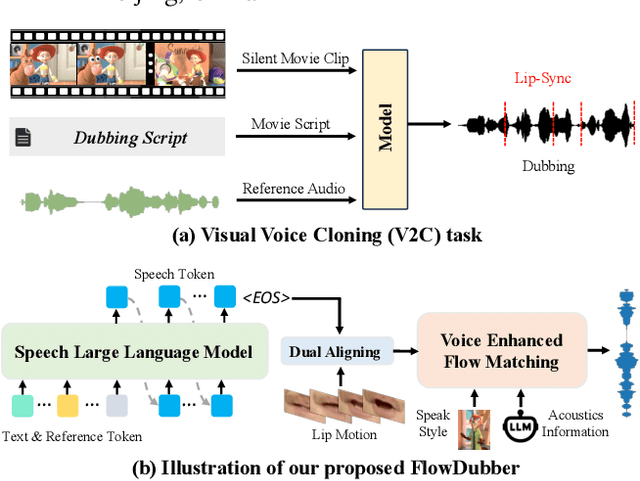

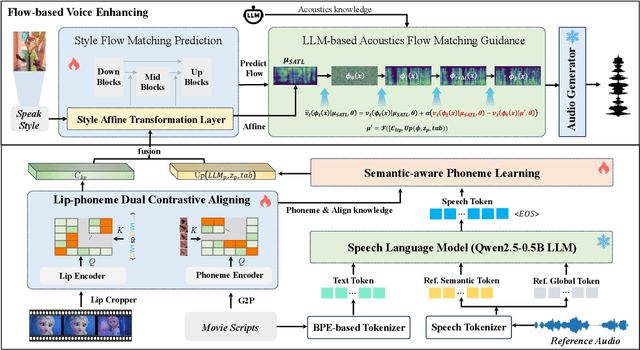

Abstract:Movie Dubbing aims to convert scripts into speeches that align with the given movie clip in both temporal and emotional aspects while preserving the vocal timbre of a given brief reference audio. Existing methods focus primarily on reducing the word error rate while ignoring the importance of lip-sync and acoustic quality. To address these issues, we propose a large language model (LLM) based flow matching architecture for dubbing, named FlowDubber, which achieves high-quality audio-visual sync and pronunciation by incorporating a large speech language model and dual contrastive aligning while achieving better acoustic quality via the proposed voice-enhanced flow matching than previous works. First, we introduce Qwen2.5 as the backbone of LLM to learn the in-context sequence from movie scripts and reference audio. Then, the proposed semantic-aware learning focuses on capturing LLM semantic knowledge at the phoneme level. Next, dual contrastive aligning (DCA) boosts mutual alignment with lip movement, reducing ambiguities where similar phonemes might be confused. Finally, the proposed Flow-based Voice Enhancing (FVE) improves acoustic quality in two aspects, which introduces an LLM-based acoustics flow matching guidance to strengthen clarity and uses affine style prior to enhance identity when recovering noise into mel-spectrograms via gradient vector field prediction. Extensive experiments demonstrate that our method outperforms several state-of-the-art methods on two primary benchmarks. The demos are available at {\href{https://galaxycong.github.io/LLM-Flow-Dubber/}{\textcolor{red}{https://galaxycong.github.io/LLM-Flow-Dubber/}}}.
SDVPT: Semantic-Driven Visual Prompt Tuning for Open-World Object Counting
Apr 24, 2025



Abstract:Open-world object counting leverages the robust text-image alignment of pre-trained vision-language models (VLMs) to enable counting of arbitrary categories in images specified by textual queries. However, widely adopted naive fine-tuning strategies concentrate exclusively on text-image consistency for categories contained in training, which leads to limited generalizability for unseen categories. In this work, we propose a plug-and-play Semantic-Driven Visual Prompt Tuning framework (SDVPT) that transfers knowledge from the training set to unseen categories with minimal overhead in parameters and inference time. First, we introduce a two-stage visual prompt learning strategy composed of Category-Specific Prompt Initialization (CSPI) and Topology-Guided Prompt Refinement (TGPR). The CSPI generates category-specific visual prompts, and then TGPR distills latent structural patterns from the VLM's text encoder to refine these prompts. During inference, we dynamically synthesize the visual prompts for unseen categories based on the semantic correlation between unseen and training categories, facilitating robust text-image alignment for unseen categories. Extensive experiments integrating SDVPT with all available open-world object counting models demonstrate its effectiveness and adaptability across three widely used datasets: FSC-147, CARPK, and PUCPR+.
ProgRoCC: A Progressive Approach to Rough Crowd Counting
Apr 18, 2025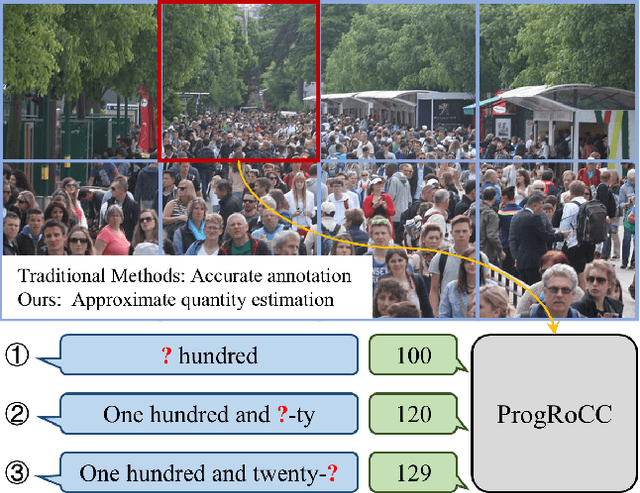
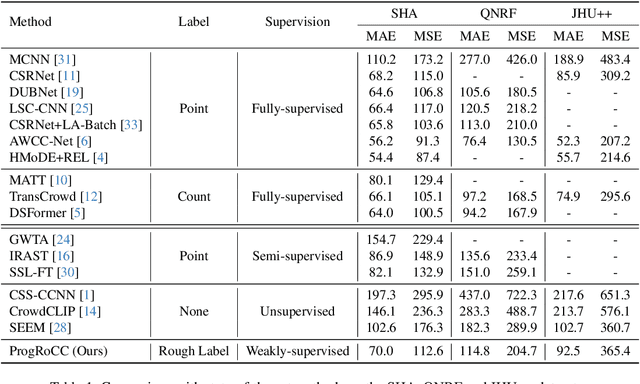
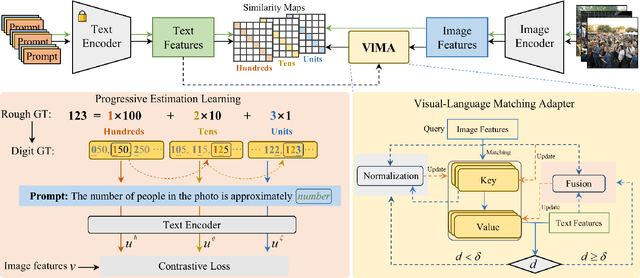

Abstract:As the number of individuals in a crowd grows, enumeration-based techniques become increasingly infeasible and their estimates increasingly unreliable. We propose instead an estimation-based version of the problem: we label Rough Crowd Counting that delivers better accuracy on the basis of training data that is easier to acquire. Rough crowd counting requires only rough annotations of the number of targets in an image, instead of the more traditional, and far more expensive, per-target annotations. We propose an approach to the rough crowd counting problem based on CLIP, termed ProgRoCC. Specifically, we introduce a progressive estimation learning strategy that determines the object count through a coarse-to-fine approach. This approach delivers answers quickly, outperforms the state-of-the-art in semi- and weakly-supervised crowd counting. In addition, we design a vision-language matching adapter that optimizes key-value pairs by mining effective matches of two modalities to refine the visual features, thereby improving the final performance. Extensive experimental results on three widely adopted crowd counting datasets demonstrate the effectiveness of our method.
The Devil is in the Distributions: Explicit Modeling of Scene Content is Key in Zero-Shot Video Captioning
Mar 31, 2025


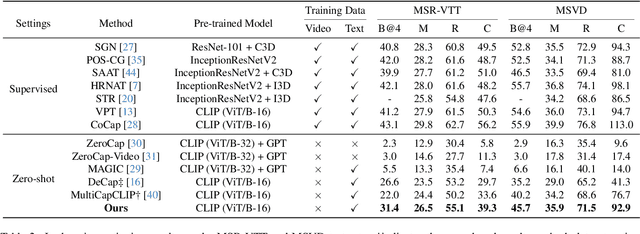
Abstract:Zero-shot video captioning requires that a model generate high-quality captions without human-annotated video-text pairs for training. State-of-the-art approaches to the problem leverage CLIP to extract visual-relevant textual prompts to guide language models in generating captions. These methods tend to focus on one key aspect of the scene and build a caption that ignores the rest of the visual input. To address this issue, and generate more accurate and complete captions, we propose a novel progressive multi-granularity textual prompting strategy for zero-shot video captioning. Our approach constructs three distinct memory banks, encompassing noun phrases, scene graphs of noun phrases, and entire sentences. Moreover, we introduce a category-aware retrieval mechanism that models the distribution of natural language surrounding the specific topics in question. Extensive experiments demonstrate the effectiveness of our method with 5.7%, 16.2%, and 3.4% improvements in terms of the main metric CIDEr on MSR-VTT, MSVD, and VATEX benchmarks compared to existing state-of-the-art.
Visual and Semantic Prompt Collaboration for Generalized Zero-Shot Learning
Mar 29, 2025Abstract:Generalized zero-shot learning aims to recognize both seen and unseen classes with the help of semantic information that is shared among different classes. It inevitably requires consistent visual-semantic alignment. Existing approaches fine-tune the visual backbone by seen-class data to obtain semantic-related visual features, which may cause overfitting on seen classes with a limited number of training images. This paper proposes a novel visual and semantic prompt collaboration framework, which utilizes prompt tuning techniques for efficient feature adaptation. Specifically, we design a visual prompt to integrate the visual information for discriminative feature learning and a semantic prompt to integrate the semantic formation for visualsemantic alignment. To achieve effective prompt information integration, we further design a weak prompt fusion mechanism for the shallow layers and a strong prompt fusion mechanism for the deep layers in the network. Through the collaboration of visual and semantic prompts, we can obtain discriminative semantic-related features for generalized zero-shot image recognition. Extensive experiments demonstrate that our framework consistently achieves favorable performance in both conventional zero-shot learning and generalized zero-shot learning benchmarks compared to other state-of-the-art methods.
Prosody-Enhanced Acoustic Pre-training and Acoustic-Disentangled Prosody Adapting for Movie Dubbing
Mar 15, 2025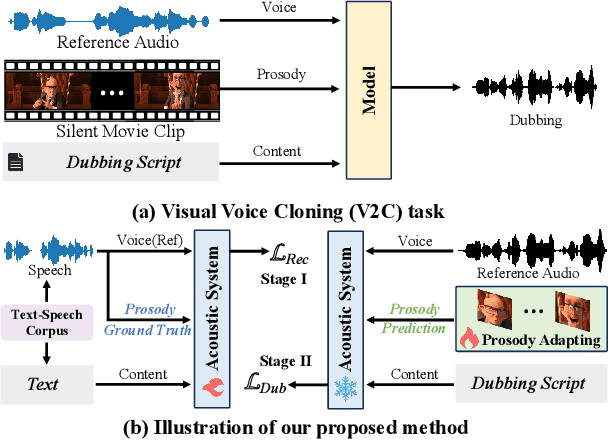

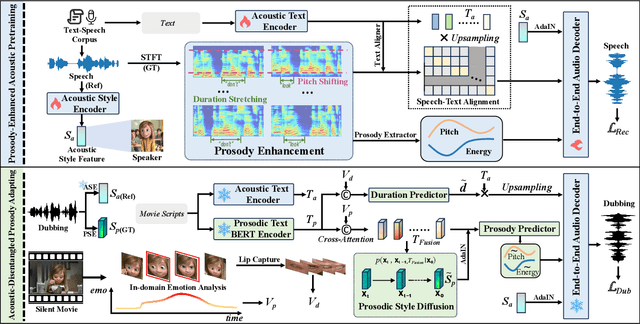

Abstract:Movie dubbing describes the process of transforming a script into speech that aligns temporally and emotionally with a given movie clip while exemplifying the speaker's voice demonstrated in a short reference audio clip. This task demands the model bridge character performances and complicated prosody structures to build a high-quality video-synchronized dubbing track. The limited scale of movie dubbing datasets, along with the background noise inherent in audio data, hinder the acoustic modeling performance of trained models. To address these issues, we propose an acoustic-prosody disentangled two-stage method to achieve high-quality dubbing generation with precise prosody alignment. First, we propose a prosody-enhanced acoustic pre-training to develop robust acoustic modeling capabilities. Then, we freeze the pre-trained acoustic system and design a disentangled framework to model prosodic text features and dubbing style while maintaining acoustic quality. Additionally, we incorporate an in-domain emotion analysis module to reduce the impact of visual domain shifts across different movies, thereby enhancing emotion-prosody alignment. Extensive experiments show that our method performs favorably against the state-of-the-art models on two primary benchmarks. The demos are available at https://zzdoog.github.io/ProDubber/.
Exploring Primitive Visual Measurement Understanding and the Role of Output Format in Learning in Vision-Language Models
Jan 25, 2025



Abstract:This work investigates the capabilities of current vision-language models (VLMs) in visual understanding and attribute measurement of primitive shapes using a benchmark focused on controlled 2D shape configurations with variations in spatial positioning, occlusion, rotation, size, and shape attributes such as type, quadrant, center-coordinates, rotation, occlusion status, and color as shown in Figure 1 and supplementary Figures S3-S81. We fine-tune state-of-the-art VLMs (2B-8B parameters) using Low-Rank Adaptation (LoRA) and validate them on multiple out-of-domain (OD) scenarios from our proposed benchmark. Our findings reveal that coherent sentence-based outputs outperform tuple formats, particularly in OD scenarios with large domain gaps. Additionally, we demonstrate that scaling numeric tokens during loss computation enhances numerical approximation capabilities, further improving performance on spatial and measurement tasks. These results highlight the importance of output format design, loss scaling strategies, and robust generalization techniques in enhancing the training and fine-tuning of VLMs, particularly for tasks requiring precise spatial approximations and strong OD generalization.
Adapter-Enhanced Semantic Prompting for Continual Learning
Dec 15, 2024



Abstract:Continual learning (CL) enables models to adapt to evolving data streams. A major challenge of CL is catastrophic forgetting, where new knowledge will overwrite previously acquired knowledge. Traditional methods usually retain the past data for replay or add additional branches in the model to learn new knowledge, which has high memory requirements. In this paper, we propose a novel lightweight CL framework, Adapter-Enhanced Semantic Prompting (AESP), which integrates prompt tuning and adapter techniques. Specifically, we design semantic-guided prompts to enhance the generalization ability of visual features and utilize adapters to efficiently fuse the semantic information, aiming to learn more adaptive features for the continual learning task. Furthermore, to choose the right task prompt for feature adaptation, we have developed a novel matching mechanism for prompt selection. Extensive experiments on three CL datasets demonstrate that our approach achieves favorable performance across multiple metrics, showing its potential for advancing CL.
 Add to Chrome
Add to Chrome Add to Firefox
Add to Firefox Add to Edge
Add to Edge